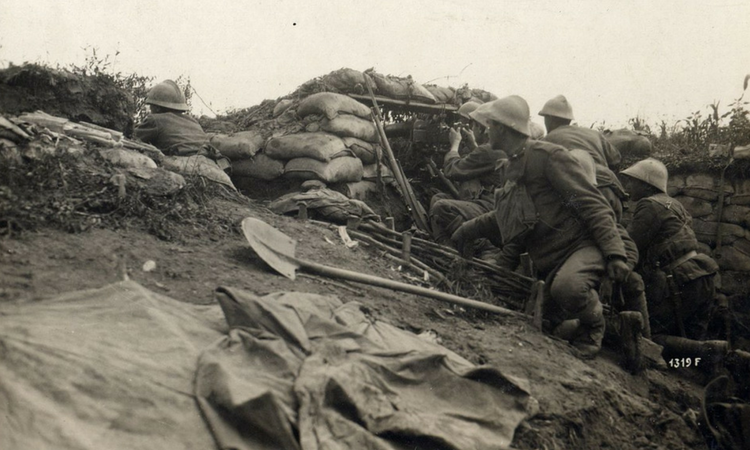14 June 2018
11 things you need to know about the battle of the Piave River

Friday (15 June) will mark 100 years since the start of WW1's Battle of the Piave River. Fought between 15 and 23 June 1918, the battle was a victory for the Italian army against the Austro-Hungarian Empire.
- Despite being allied to Germany and Austria-Hungary before the outbreak of the First World War, Italy joined the war on the side of Britain and France in May 1915.
- The first British troops to serve on the Italy Front arrived in April 1917, when heavy artillery and supporting Indian logistical units were sent to rereinforce the Italian Army.
- Eleven battles of Isonzo were fought between May 1915 and September 1917, along the Isonzo (Soca in Slovene) river valley which formed part of the border between Italy and Austro-Hungary.
- On 24 October 1917, Austro-Hungarian forces supported by German troops went on the offensive breaking the deadlock. During what became known as the Battle of Caporetto Italian forces were driven back over 100km across northern Italy to within 30km of Venice, to a line along the Paive River.
- British and French forces were rushed to Italy from the Western Front, where the Allies were engaged in the Battle of Third Ypres, to support the beleaguered Italian forces.
- In March 1918, some British, French and German troops were redeployed from Italy to the Western Front in preparation for the imminent German Spring Offensive. This left three British and three French divisions in Italy holding a section of the line around the strategically important Asiago Plateau in the foothills of the Alps.
- In June 1918, Austro-Hungarian forces launched another offensive along a broad front, some 110km from the shores of the Adriatic to Asiago Plateau.
- The timing of the Austro-Hungarian attack was known to the Allies, and their artillery opened up on the Austro-Hungarian lines 30 minutes before the beginning of the attack. Despite this bombardment Austro-Hungarian forces managed to make some gains close to the coast and across the Asiago Plateau.
- The Austro-Hungarian attack quickly faltered, Italian, French and British troops counter-attacked, driving the Austro-Hungarian forces back to their start positions along the Piave River, where many hundreds of Austro-Hungarian troops were killed trying to escape back across the river.
- Allied casualties were in the region of 85-87,000, while estimates of Austro-Hungarian losses range from between 69-118,000, wounded, missing or killed.
- The CWGC commemorates in Italy nearly 450 British Army servicemen and one Indian labourer who died during the Battle of the Piave. More than 125 are commemorated in Magnaboschi British Cemetery, over 95 in Boscon British Cemetery and more than 60 in Granezza British Cemetery, while a further 15 are named on the Giavera Memorial to the missing.
Remembering Lance Corporal Allen Richard Hart

1st/7th Battalion, Worcestershire Regiment
Died: 15 June 1918
Aged: 22
Buried in: Magnaboschi British Cemetery
Born in 1869 in Eastnor, Hereford, Allen was one of 12 children. His father Sidney ran a greengrocers and poultry business, aided by some of his older children including Allen.
During the war, five of the brothers served with the British Army all with different units. Allen joined the 1st/8th battalion of the Worcestershire Regiment and after training was sent to France in May 1916. He trained as a Lewis gunner and in July, along with his battalion, he was preparing to take part in the Battle of the Somme when on the night of 19/20 July, while behind the lines they were targeted by German artillery firing gas shells. Allen along with 70 other members of his battalion were affected and sent to hospital.
In December 1916, having recovered Allen was transferred to 1st/7th battalion, Worcestershire Regiment which had suffered heavy casualties during the Battle of the Somme. In 1917 Allen took part in the Battle of Third Ypres. In November his battalion was transferred to Italy.
In December, Allen’s brother Corporal Reginald Hart was killed while serving with the Royal Field Artillery near Ypres. He is buried in Oxford Road Cemetery, Belgium. Two months later their eldest brother Private Sidney Joseph Hart was killed in action while serving with the 11th battalion, Worcestershire Regiment at Salonika. He is buried in Karasouli Military Cemetery, Greece.
On 15 June 1918, Allen and the 1st/7th Worcestershires were holding the frontlines along the Asiago Plateau when the Austrians launched their offensive. Allen was killed on the first day of the attack. He was 22 years old. After the battle his Company Commander, Captain Henry Wood, wrote to his parents:
“It is with feelings of the deepest regret that I have to write to you of the death of your son. He was killed by fire from an Austrian Machine gun, while leading his section in a counter attack against the enemy on 15th June. It was owing to the splendid manner in which your son and his brother non-commissioned officers led their sections, and obeyed their orders, that this attack finally succeeded. I as his company commander, am very sorry to have lost a very promising N.C.O. Your son is buried with his comrades which fell in this action in the British cemetery close by. I should like to express the greatest sympathy of the officers, non-commissioned officers and men of the company with you in your present loss.”
Allen is buried in Magnaboschi British Cemetery, alongside 20 men of his battalion who died during the battle.

